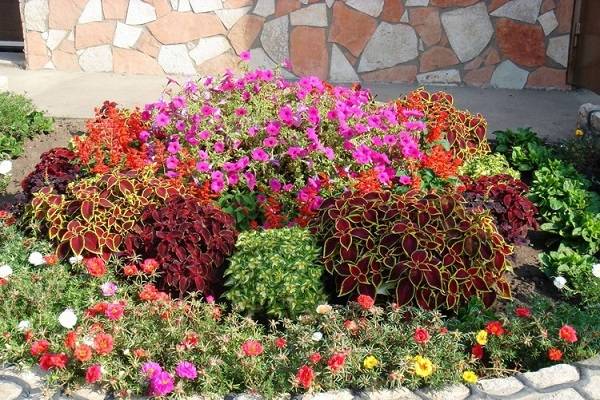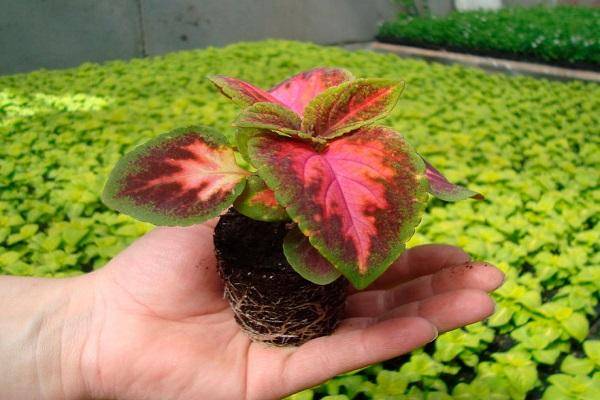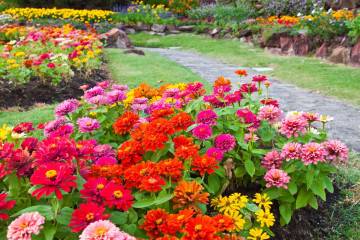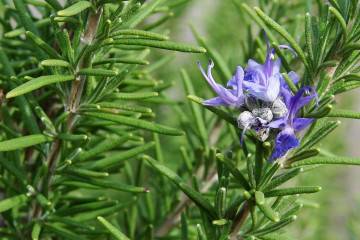Coleus flower - care and cultivation in the open field
Content:
Colorful Coleus plants can easily transform any planting site. Due to their charm, they are used to create decorative leafy compositions in landscape design. But the flower is also grown at home.
Description of coleus (nettles)
The name Coleus comes from Latin and means "case". Why they named it that way is unknown.
The flower belongs to the Lamb family. Coleus is a flower popularly called nettle.
The origin and appearance of the plant
The history of the plant begins from its homeland - the forest regions of the Asian and African continents. The tropical inhabitant, even under conditions of home cultivation, has maintained the requirements for high humidity, sufficient light, and warm temperature. In general, caring for him is simple.
Outwardly, it is a low-growth shrub. Shoots have 4 edges. At the base, they stiffen. The leaves resemble the shape of a heart, they are small, up to 6 cm long. The edges are jagged. The leaf plate can be painted in a wide variety of colors. Combinations of burgundy, green, red, yellow, pink are often found.
Some especially superstitious flower growers are interested in the question about the coleus: is it possible to keep this flower at home? This is due to the belief that the plant is harmful, attracting poverty into the house. Of course it is not. The origin of "false" views is associated with the second name - nettle and comparison with another croton flower. This is where the substitution and confusion arose. The plants are completely different from each other, so the Coleus was called poor.
The use of coleus for decorative purposes
The colorful color of the leaves allows you to safely use the shrub in landscape design. In winter, they decorate the premises, and in the summer - gardens and parks. They are used for single plantings, creating flower beds, borders. Shrubs planted along one of the walls of the house look beautiful.
Popular types of coleus for growing in the garden
To date, more than 400 plant species are known. Each of them has its own distinctive features. Here are just a few varieties.
Coleus Blume
This is a whole group of varieties. It was she who laid the foundation for the creation of the rest of the hybrid species. It includes many species with different colors. Common features that unite all representatives of Blume are the shape of the leaf plate in the form of an egg and rounded edges (without teeth). The palette of colors is diverse: brown, blue, white, black, red, purple, cream and others. The most famous varieties:
- Orange;
- Zarya;
- Fun.
Coleus Black Dragon
This variety is loved for its unusual appearance and color. The leaves are painted in a rich purple-burgundy color, which is quite rare. Sometimes its edges may be colored green, and there may also be a speck of pink tint. The plant adds luxury to the velvety leaves, which is inherent in many hybrids. Increased humidity is the only requirement of the grade.
Coleus Renault
Compact shrub. Most often it is used as an ampelous one. Leaves can be of different colors. The only thing that is invariable is the presence of streaks of crimson or red, purple colors on them.
Dog coleus
Additional names - plekranthus, bristle flower. The name, strange at first glance, appeared due to the pronounced aroma of the flower, which begins to spread quickly at the slightest touch to it. Thanks to this property, it can be beneficial in the garden, protecting plantings from pests. It is enough just to plant shrubs around the perimeter of the beds.
Of the decorative ones, Avatar, Velvet, etc. are popular.
Growing conditions
You can get a beautiful shrub only with proper care and compliance with certain growing conditions:
- sufficient amount and intensity of light;
- in the afternoon, it is preferable to shade the plant a little;
- compliance with the temperature regime: in summer from 18 ° С, in winter from 12 ° С;
- frequent and abundant moistening of the earth;
- regular spraying;
- fertilization according to the season.
Growing coleus from seeds
One way to reproduce is by planting seeds. This is a difficult method that requires patience and accuracy.
When to plant seeds for seedlings
They begin to sow seeds in the last days of March. So you can get a voluminous powerful shrub by the time of planting in the garden in open ground. The soil enriched with nutrients is prepared in advance, which includes turf, humus, peat. They contain everything necessary for the seeds to sprout.
Seedling care
The seeds do not need to be placed deep in the ground, as it will be difficult for them to germinate, therefore they are placed almost on the surface, slightly sprinkling with sand on top. Cover with glass on top to create a greenhouse effect. Minimum lighting is required. It is important to moisten the soil in a timely manner, avoiding drying out.
Seedling care
The direct rays of the sun are detrimental to potential plants. Upon reaching the age of 30 days, the seedlings, as a rule, are already ready for picking into separate compact pots no more than 7 cm in diameter.
At this stage, you need to look after as a full-fledged adult shrub. It is recommended to transplant seedlings at the age of 60 days in a larger container, up to 12 cm in diameter, and start pinching the shoots of the upper part. This is necessary for the speedy build-up of the bulk.
When and how to plant Coleus in open ground
Choosing a coleus plant, planting and care in the open field does not require a lot of money and effort. It is enough to remember that the shrub is native to the tropics, therefore it loves warmth.In this regard, it is possible to plant only in the soil well warmed up by the spring sun. The likelihood of frost return should be minimized.
For boarding, the evening period after 18:00 is suitable. The best place is open to the sun and closed from drafts. The soil should consist of peat, turf, river sand and earth (1: 1: 1: 1). Place the resulting mixture in the planting pit.
Further care
Immediately after planting the seedlings, the soil is shed well. The water should be at room temperature. Coleus flowers love water, so frequent watering is required. After the procedure, the soil is loosened, weeds are removed.
Watering as part of caring for Coleus at home is reduced in winter. Water as needed when the soil surface is dry. Lack of watering is determined by the state of the leaves, which begin to wilt.
How to feed Coleus
The frequency of feeding depends on the season. In summer, top dressing is applied weekly from the beginning of March, when nature begins to wake up after winter. Begin by applying nitrogenous fertilizers to stimulate flowering. Thus, they are fed before the onset of cold weather in the fall.
From autumn to winter, they are fed once a month. The fertilizer is diluted with water. For the best effect, take several funds and alternate. The best compatibility in this regard is with organics and minerals.
Features of care during flowering
During the flowering of Coleus, the care changes slightly. Blooming itself is always a process that requires a lot of energy. In relation to this plant, you need to direct all efforts to growing leaves, and not to collecting and harvesting seeds.
The tropical guest will bloom with elongated spikelets with small lilac flowers. At the beginning of the ejection, the spikelet is cut off. It is not necessary to process the cut site.
Features of care during the rest period
Caring for Coleus at home during a rest period is even easier than in the open field. Watering in winter is reduced. Fresh air will be more important in winter. Regular spraying and remoteness from heating devices will help preserve the decorative effect of the shrub until spring.
A thermophilic phyto-friend will feel comfortable at 16-18 ° C in winter. A decrease in temperature in winter to 12 ° C can cause leaves on the bush to drop. The lighting should be abundant, but without direct sunlight.
In February, the period of active awakening of the plant begins. The bush is cut, watering and feeding begin to increase. If you plan to plant a bush for the summer in open ground, you need to do a complete pruning of the shoots. Leaving 5-6 eyes for renewal, after active growth, you can get a young plant with a well-developed root mass. Transplanting such a bush into open ground does not require an adaptation period.
Transplant and reproduction
The plant is grown outdoors as a perennial or annual, depending on the climate. When conditions permit, they are transplanted to a new place for 3 or 4 years. During this time, flower growers with experience have gotten used to completely renewing the shrub, since decorativeness disappears with age.
Coleus perennial, growing at home, or in other words, indoor, requires a transplant in the spring every year.
Coleus is propagated by cuttings. With the help of a cutting, you can quickly and easily root a new plant either directly in the ground or in water before the first roots appear. The right time for this type of breeding is from the second half of winter to the end of spring. Every 28 days, the cutting is moved to a larger container.
Freshly rooted shoots require mandatory compliance with a temperature regime of 16 ° C, timely soil moisture, a high level of humidity, and a sufficient amount of light. The soil should allow air to flow well to the roots. You can cook it yourself from humus, peat and turf, or you can buy it ready-made in specialized stores.
Preparing for winter
At the end of August, a decrease in temperature begins, and sharp changes are also observed, which are difficult to transfer to an exotic plant in open conditions. Therefore, at the first cold snap, the shrubs are transferred home from the site. Transplanted into a pot for wintering. The annual variety is divided into cuttings and planted.
Potential pests and diseases
For Coleus of all types, the danger is whitefly, mite (spiderweb), lionfish. To prevent their appearance, it is worth systematically inspecting the foliage and stems. This simple procedure helps to detect pests during the initial breeding stage.
The diseased flower is separated from the rest of the houseplants. If necessary, they are treated with fungicides, insecticides. When a large part is affected, it is possible, as an option, to carry out cuttings of healthy shoots and get new shrubs.
Disease prevention
The only prevention of the Coleus flower is planting and care, carried out correctly and at the right time.
Here are some common grooming mistakes:
- direct rays of the sun can cause burns;
- lack of lighting is the result of sluggish, pale leaves;
- a low level of humidity is reflected by the appearance of spots on the sheet plates;
- an insufficient amount of nutrients leads to the discharge of foliage, starting from the lower part (feeding is especially required in the autumn period);
- reduced daylight hours (in winter) leads to elongated shoots with sparsely spaced leaves.
Having chosen a coleus plant, planting and care, cultivation does not require much time and effort. The flower is unpretentious. It is enough to provide him with watering, access to light, feeding in order to get a new, updated design of the garden or room. The fiery color of the foliage of certain varieties will warm and remind you of summer in winter.























